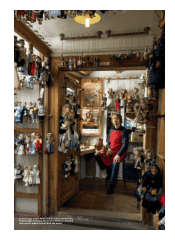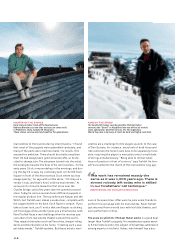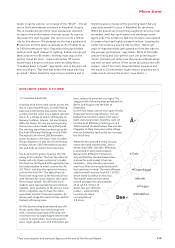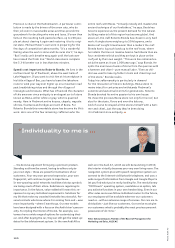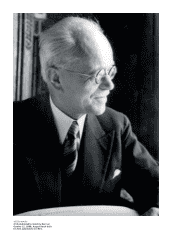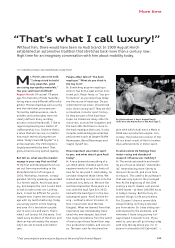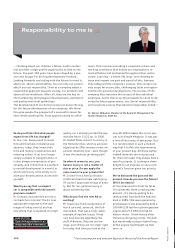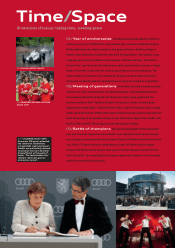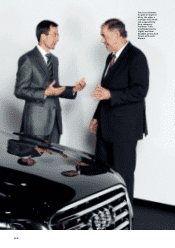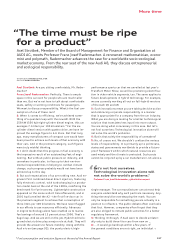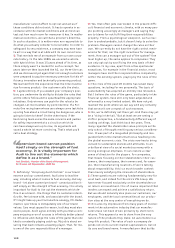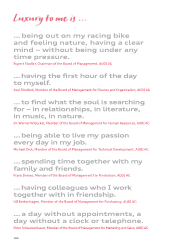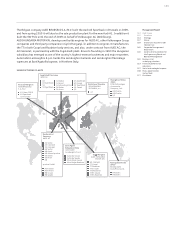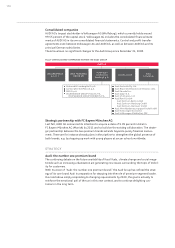Audi 2009 Annual Report Download - page 130
Download and view the complete annual report
Please find page 130 of the 2009 Audi annual report below. You can navigate through the pages in the report by either clicking on the pages listed below, or by using the keyword search tool below to find specific information within the annual report.Axel Strotbek: Are you sitting comfortably, Mr. Rader-
macher?
Franz Josef Radermacher: Perfectly. There is ample
space in this car even for people who are much taller
than me. But we’re not here to talk about comfortable
seats, safety or working conditions for passengers.
We want to discuss responsibility. What’s the fuel con-
sumption of one of these cars?
S: When it comes to efficiency, we’ve achieved some-
thing of a quantum leap with the new A8. With the
258 kW (350 hp) eight-cylinder diesel engine, this car
averages 7.6 liters per 100 kilometers.* For the six-
cylinder diesel version with quattro drive, we have im-
proved the average figure to 6.6 liters. Not that long
ago, many manufacturers of compact cars would have
been proud to achieve such levels of fuel economy with
their cars. And in the premium category, such figures
were truly wishful thinking.
R: I don’t doubt that this progress in fuel economy is
the impressive result of an outstanding feat of engi-
neering. But without public pressure on industry, and
carmakers in particular, to face up to their environ-
mental responsibilities in helping to combat climate
change, such progress probably would not have been
achieved up to this day.
S: But such expectations of us are nothing new. Audi en-
gineers first combined diesel direct injection, featuring
fully electronic control, with turbocharging in a produc-
tion model back at the end of the 1980s, redefining the
benchmark for fuel economy. Lightweight construction
appeared on the scene a short time afterwards, and in
2001 Audi unveiled the A2 – the first five-door car in
the premium segment to achieve fuel consumption of
three liters per 100 kilometers. We have never flagged
in our efforts to use resources efficiently. Advances
in engine technology alone have enabled us to realize
fuel savings of around 15 percent since 2006. That’s a
huge leap. And we are still on the job. Hybrid technolo-
gy and electric drive play a major role at Audi. They will
provide the answers to future mobility. Along with the
Audi e-tron (see page 92), the purely electric high-
performance sports car that we unveiled at last year’s
Frankfurt Motor Show, we will be promoting electrifica-
tion in other vehicle segments, too. The same applies to
future developments in hybrid technology. For example,
we are currently working all-out on full-hybrid versions
of the Audi Q5 and A8.
R: Such innovations mean you are taking decisive action
and embracing corporate responsibility in a manner
that is appropriate for a company from the car industry.
What you are doing is looking for a better technological
solution that translates less input into more output.
You are doing what is necessary in this area. But let’s
not fool ourselves: Technological innovation alone will
not solve the world’s problems.
S: But is that solely the responsibility of carmakers?
R: No, of course not. We shouldn’t confuse the various
levels of responsibility. It is primarily up to politicians,
states and governments worldwide to provide a future-
proof framework within which natural resources are
used wisely and the climate is protected. Such pacts
cannot be conjured up by a car manufacturer, let alone a
single manager. The car manufacturer can at most help
everyone understand why such pacts are necessary. Any-
thing else would be overstepping the mark. You can
only be responsible for something you are actually in a
position to influence. The public debate often overlooks
that fact. However, companies often forget that they
are also obliged to initiate public activities for a better
regulatory framework.
S: Thinking it through, if Audi were to decide unilater-
ally only to build three-liter cars from now on …
R: … it would go bankrupt within a few years. If
the general conditions are not right, an individual
More time
INTERVIEW/ANDREAS MOLITOR
PHOTOS/ENNO KAPITZA
“The time must be ripe
for a product”
Axel Strotbek, Member of the Board of Management for Finance and Organization at
AUDI AG, meets Professor Franz Josef Radermacher. A renowned mathematician, econo-
mist and polymath, Radermacher advances the case for a worldwide socio-ecological
market economy. From the rear seat of the new Audi A8, they discuss entrepreneurial
and ecological responsibility.
“
Let’s not fool ourselves.
Technological innovation alone will
not solve the world’s problems.”
Professor Franz Josef Radermacher, globalization expert
* Fuel consumption and emission figures at the end of the Annual Report 127


